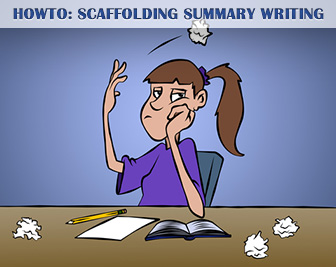HOWTO: Scaffolding Summary Writing


And this couldn’t be more true of ESL students today. Learning English is more than a series of acquisitions that a student obtains alone. It’s more than a list of words or grammar structures that an individual must grasp in order to communicate effectively in English. Learning English is not an individual, solitary effort. It is a social process, one in which interaction and collaboration are as fundamental as the vocabulary lists or grammar topics.
There are different types of collaborative tasks for ESL students, but let’s take a closer look at collaboration in interactive writing.

Simply put, interactive writing is shared writing. In some cases, the teacher and students may literally share the same pen to produce together a piece of content like a story or letter; in other cases the sharing is less literal. Students may write separately for a joint project, for example, different stories that go together in a book. Whether you have your students collaborate to produce one piece of content, or one that is a collection of their individual efforts, the possibilities for collaboration – and learning – are all there.

One of the most widely used forms of interactive writing involves having students research different aspects of one topic and then collate their findings to produce one piece of content. For example, have your class choose an animal to research, like the panda. Each student chooses what he/she will investigate, whether it is the panda’s habitat, eating habits or characteristics. Students then work together to write one paper on the panda.
Another very popular form of interactive writing is having ESL students collate individual productions into a larger project or portfolio, such as a newspaper or storybook. Each student produces his/her piece of writing. Students collaborate to deliver the final product/collection. It’s not as simple as gluing it all together. Decisions must be made as to the order of the articles/stories and if any of them should be cut/edited to fit the allotted space.
Read out loud or hand out copies of a story, but leave out the ending. Students must individually write their own ending to the story. Then, they get together and share their endings. Students comment on which were similar, which were more surprising, which they liked best. Students choose one of the endings as the official ending for the story. They may choose one and keep it as it was written, or rewrite it taking elements from different endings.
This is another classic interactive writing task. A student is given a piece of paper with the first line of the story written on it. He/she must continue the story and write the second line, then pass the paper to a classmate. When everyone has contributed to the story, the teacher reads the result out loud. Does it make sense? Is it a good story? They may do this task quietly, simply reading what the other has written before, or as a full collaboration, discussion ideas before writing down the next line.
Ask students to describe something like the classroom, a person (you!) or an object, like an electronic device. Each student contributes a piece of the description and passes the sheet of paper to the next who will add something else to it.
Another great form of interactive writing is having students work together to write a step-by-step process. What is something they can describe step by step? How to make a sandwich? How to send an email? The process can be as simple or as complex as your students’ ages and level will allow.
A much simpler form of interactive writing, and one that is perfect for young learners or beginners, is guided writing. In this case, the teacher starts the sentence and students must complete it. The teacher may also give students different options. For example, write on the board: On weekends, it’s fun to…. Students submit different ideas. Based on the idea, you continue writing as a group. The students’ contributions shape the final written result.
Collaborative writing projects are tremendously enriching for ESL students. The focus is placed less on the teacher and more on the students’ learning experience. We are not there to hand down or deliver knowledge. We are there to facilitate learning and guide students in their efforts.
Students may collaborate over 15 minutes or over several days. The important thing is not the how long or the how, but rather the what they produce. It will be a unique piece, the fruit of their labor, but also a meaningful learning experience they have cultivated together.